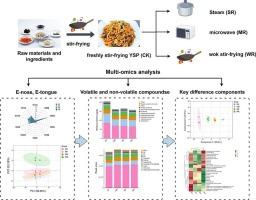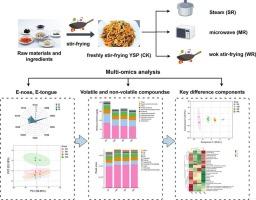Multi-omics profiling delineates reheating-modality-driven flavor divergence in Yuxiang shredded pork
IF 9.8
1区 农林科学
Q1 CHEMISTRY, APPLIED
引用次数: 0
Abstract
Systematically deconstructing flavor divergence in reheated cuisine is crucial for optimizing its sensory quality. This study pioneeringly integrated multi-omics approaches (E-nose, E-tongue, GC–MS, LC-MS) to systematically compare microwave (MR), steam (SR), and wok stir-frying (WR) reheating modalities against freshly stir-frying Yuxiang Shredded Pork (YSP). Results revealed that freshly stir-frying YSP exhibited 327.4 μg/kg volatile compounds, 18.3–26.7 % higher than reheated groups, with aldehydes, esters, and sulfur compounds as key aroma contributors. WR proved superior for aroma regeneration, restoring key aldehydes like hexanal to 89.4 % of fresh levels. In contrast, SR and MR excelled at preservation, retaining >85 % of crucial sulfur compounds. Non-volatile analysis showed WR uniquely enhanced taste, with a majority of the key differential amino and organic acids reaching their highest levels in this group, while MR accelerated the degradation of key triglycerides. These findings establish reheating-specific flavor optimization guidelines, guiding reheating strategies for flavor preservation in traditional cuisines.


多组学分析描述了玉香肉丝的加热方式驱动的风味差异
系统地解构再加热菜肴的风味差异是优化其感官品质的关键。本研究开创性地整合了多组学方法(E-nose、E-tongue、GC-MS、LC-MS),系统地比较了微波(MR)、蒸汽(SR)和炒锅(WR)再加热方式对鲜炒鱼香肉丝(YSP)的影响。结果表明,新炒的YSP挥发性化合物含量为327.4 μg/kg,比再加热组高18.3 ~ 26.7%,其中醛类、酯类和硫类化合物是主要的香气来源。WR在香气再生方面表现优异,将己醛等关键醛恢复到89.4%的新鲜水平。相比之下,SR和MR在保存方面表现出色,保留了85%的关键硫化合物。非挥发性分析显示,WR独特地增强了口感,大多数关键的差异氨基酸和有机酸在该组中达到了最高水平,而MR加速了关键甘油三酯的降解。这些发现建立了针对再加热的风味优化指南,指导了传统菜肴的再加热风味保存策略。
本文章由计算机程序翻译,如有差异,请以英文原文为准。
求助全文
约1分钟内获得全文
求助全文
来源期刊

Food Chemistry
工程技术-食品科技
CiteScore
16.30
自引率
10.20%
发文量
3130
审稿时长
122 days
期刊介绍:
Food Chemistry publishes original research papers dealing with the advancement of the chemistry and biochemistry of foods or the analytical methods/ approach used. All papers should focus on the novelty of the research carried out.
 求助内容:
求助内容: 应助结果提醒方式:
应助结果提醒方式:


